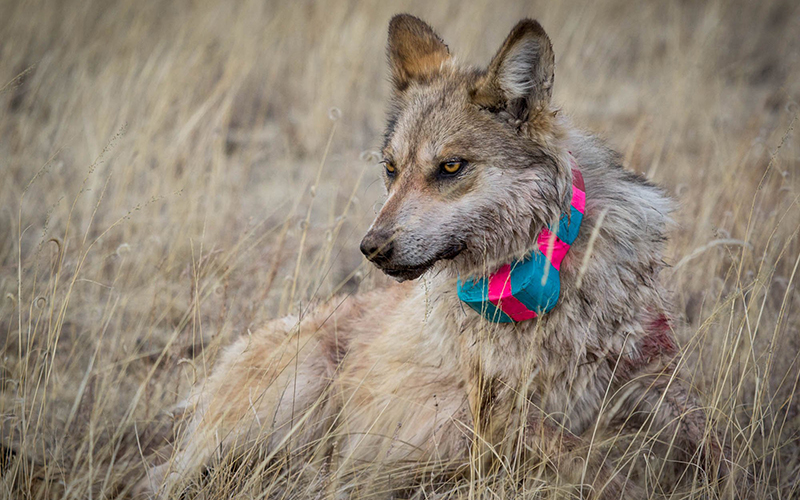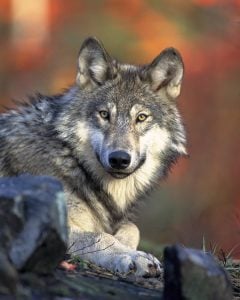
Researchers fitted this Mexican gray wolf with a radio collar in 2018. Tracking the animals in the wild is part of a decades-long effort to reintroduce the subspecies, which was nearly extinct in the 1970s. (File photo by Jenna Miller/Cronkite News)
PHOENIX – A U.S.-Mexico partnership could aid the long-term recovery of the endangered Mexican wolf, a subspecies of the North American gray wolf, and its eventual removal from the U.S. endangered species list, according to a new study.
In a peer-reviewed study published Jan. 21, researchers from several universities in Mexico, the University of Arizona and wildlife officials found that a suitable habitat exists in the southwestern U.S. and the Occidental and Oriental ranges of the Sierra Madre in northern Mexico where Mexican wolves can be restored to their “historical ecological role” in the wild.
The Mexican wolf population – formerly known as the Mexican gray wolf and found in parts of Arizona, New Mexico and northern Mexico – was nearly exterminated from the wild in the early 1970s, and Arizona wildlife officials agree that recovery of this “keystone species” requires coordination.
In 1998, the first four Mexican wolves were reintroduced into the Arizona wild through a cooperative effort with the U.S. Fish and Wildlife Service, the New Mexico Game and Fish Department and the U.S. Forest Service. Today, Arizona has nearly 20 times that number of wolves living in the wild, and dozens more roam across the state line in New Mexico.
“Let’s look at the overall program, not just the U.S. program, not just the Arizona program,” said Jim deVos, assistant director for wildlife management at the Arizona Game & Fish Department. “Let’s look at the true recovery of the Mexican wolf and reestablish it as a component of biodiversity.”
To determine suitable habitat, the study combined data from multiple algorithms to calculate potential risk-factors, prey populations and environmental variables, which the scientists and wildlife officials called an improvement on simpler earlier attempts.
Using new mapping data, the research is the first to include the number of prey living across wolf habitat to assess sustainable environments.
“As part of many other binational conservation efforts, this analysis provides key information showing where Mexican wolves have the highest probability of thriving,” said the study’s lead scientist, Enrique Martinez-Meyer, Ph.D., of Universidad Nacional Autónoma de México.
Recent census data found an annual 15% increase in the Mexican wolf population for the past decade with a single-year increase of 24% in 2019, raising the minimum number of wolves in the wild to about 190 – 76 in eastern Arizona, 87 in western New Mexico and more than 30 in northern Mexico.
Conservation efforts have clashed with cattle ranchers for decades in the Southwest. All Mexican wolves in the wild today are descendants of seven wolves that were spared from extinction after the livestock industry nearly eradicated the predators in the early 1970s. The wolves were added to the Endangered Species Act in 1976 and reintroduced into the Southwest in 1998.
Despite federal protection, longstanding conflict with ranchers has overshadowed the recovery process.

The North American gray wolf last year lost protection on the U.S. Fish and Wildlife Services’ endangered species list, but conservationists are suing to overrule the decision. (Photo by Gary Kramer/U.S. Fish and Wildlife Service, via pexels.com)
Last year, the Fish and Wildlife Service authorized the killing of four Mexican wolves in New Mexico after a string of attacks on livestock.
With the rising wolf population, deVos said, ranchers and wildlife officials have seen an increase in wolf attacks.
State and federal wildlife officials have provided a range of strategies to decrease the number of livestock lost to wolves, such as compensating ranchers for killed livestock and funding nonlethal avoidance measures, such as hiring range riders to oversee grazing cattle in wolf country.
“I think that by and large, ranchers are trying to work more diligently to reduce depredations,” deVos said. “Some of the really, hardened oppositions that I saw five and 10 years ago is not as hardened as it once was.”
In wolf country, ranchers have changed breeding seasons, calving locations and grazing patterns to protect vulnerable animals from wolf packs.
After federal officials confirm wolves to be responsible for the death of livestock, ranchers may be compensated for their losses with the average payment to ranchers being about $1,000, according to the Fish and Wildlife Service.
Meanwhile, a separate conflict over the northern gray wolf – a genetically distinct relative of the Mexican wolf – is brewing between wolf activists and federal officials over the decision in late October to take the gray wolf off of the endangered species list, which became effective Jan. 4. The Fish and Wildlife Service defended the move in a letter to conservation groups Jan. 28.
“We made our delisting determination using the best scientific and commercial data available and properly evaluated all relevant factors as required by the ESA (Endangered Species Act) and APA (Administrative Procedure Act),” the letter said.
Without federal protection, wolf management will fall to individual states, a move some activists fear will prove to be devastating to the gray wolf’s population.
The shift came after the Fish and Wildlife Service determined the species’ population was no longer at risk, which prompted a lawsuit from six conservation groups. It claims the shift is “an abuse of discretion” under current law, according to court documents.
Both sides agree that the wolf is a keystone species – meaning an organism that balances and holds its ecosystem together. However, wolf advocates say the decision to lift the gray wolf’s federal protection ignores the “best available science,” court documents said.
Mexican wolves are listed separately from the gray wolf, which is found in northern U.S. states and Canada, and will continue to be protected under the Endangered Species Act no matter the outcome of the lawsuit.
The lawsuit argues gray wolves are “not ready to be removed” and have not “fully recovered across much of their historic range,” said Bart Melton, wildlife program director for the National Parks Conservation Association.
“Lifting those federal protections too soon, too early on, when the science doesn’t say it’s the right thing to do, is not going to be good for recovery,” Melton said. “So my biggest fear is (wolf recovery) stalls out or we backslide.”
According to the lawsuit, “gray wolves still meet the ESA’s definition of an endangered species, one that is ‘in danger of extinction throughout all or a significant portion of its range.’”
The lawsuit claims the ruling to delist the wolves is “not based on the best available science,” said Collette Adkins, the conservation director and senior attorney with the Center for Biological Diversity, one of six plaintiffs involved in the lawsuit.
“The biggest problem with the existing rule is that it removes protections from wolves all across the country,” Adkins said, “even though there’s only been progress towards local recovery in a handful of areas.”
Today, both groups of wolves face challenges in recovering their population in their historical range through the combined efforts of conservation advocates, wildlife officials and tribal leadership.
Last year, tribes signed an intertribal Wolf Treaty in support of a ballot measure to expand the gray wolf recovery into Colorado – which passed in the November election.
“Given the cultural significance of the wolf, this treaty is now symbolic of the struggle to protect our rights and cultures, our sacred lands and waters, and the sacred beings that infuse and inhabit them,” Tom Rodgers, president of Global Indigenous Council, said at the signing. “From the wolf in the mountains to the humpback in the oceans, we will not permit their decimation just to fill the corporate trough of (then-President Donald) Trump’s enablers.”
“We’re making progress and that’s what I hope people can begin to focus on here,” deVos said. “Societal views of wolves will never merge to one. Societal views of the best management practices will probably never merge to one, but we can come closer and we need to.”
The Mexican wolf’s annual count will take place for the next five months, deVos said.
Melton, with the parks conservation association, said the collaboration with state, federal and tribal officials is “about what’s best for the species.”
“This is an act that was put in place in the spirit of bipartisan protection of threatened endangered species in this country,” he said. “And I think that we have a real opportunity right now to rally around as the climate changes and things are happening on the ground, almost quicker than we can adjust at times, the Endangered Species Act is more important than ever.”

